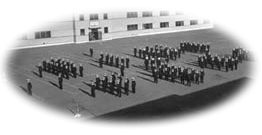The Venture Plan
Minutes of 389th Meeting of the Naval Board
Held at 1015 on Wednesday, 7 October 1953, in the Board Room
Present:
Chief of the Naval Staff
Vice Chief of the Naval Staff
Chief of Naval Technical Services
Chief of Naval Personnel
Assistant Chief of Naval Staff (Warfare)
Assistant Chief of Naval Staff (Air)
Secretary, Naval Board
Deputy Naval Secretary
Also Present:
Dr. G.S. Field, Scientific Advisor to CNS for Item I (not shown)
Commander(E) F. Harley for Item 2 (not shown)
Captain R.P. Welland for Item 3
389-3 OFFICER PROCUREMENT FOR THE RCN (NS:4600-902/100)
1. CNP reviewed the current problem in connection with the recruiting and training of officers for all branches and stated that he felt that unless emergency measures were taken at a very early date the RCN would be unable to meet its commitments planned under the 21,000 ceiling. He noted that planning figures required a total entry of 136 officers a year but that present schemes for entry of officers were only meeting a very small percentage of this requirement.
2. The Director of Naval Training presented the problem in a graph form up until the year 1969. It was evident from these graphs that special steps would have to be taken in order to meet the RCN requirement for officers.
3. The various methods by which this increase could be attained were discussed, and it appeared that there were only two choices open: (a) to increase the flow from existing schemes, or (b) to introduce a new scheme.
It was felt that none of the existing schemes could be expected to provide a steady flow of officers and in fact it was these unpredictable schemes which had brought about the present situation. It was, therefore, felt that the only realistic course of action would be to introduce some new emergency measures to overcome our current difficulty.
4. CNP, therefore, recommended that steps be taken to enter sufficient young men at the Junior Matriculation level, at ages from 16-19, into a scheme of training which requires them to serve in the navy as a career. The course of training should occupy about five years and should be applicable to the following branches: Executive, Executive Air, Engineering, Ordnance, Electrical and Supply.
5. It was noted that this scheme would have to accomplish two things:
- bridge the gap between existing schemes and the requirement. This is estimated to approximate one hundred a year.
- make up the present backlog of 895 officers which, by 1959, which is the earliest date the scheme could commence producing, will have risen to about 1400.
7. CNP stated that he recommended a total entry of 276 cadets of all branches in 1954 and that the plan be continued at this level for ten years.
8. Considerable discussion took place concerning the possible location of training facilities to meet the requirements of the plan and also as to whether the RCN could meet this additional commitment at this time. Discussion also took place concerning the possible desirability of dropping the UNTD scheme in view of the small numbers received from this source unless the officers concerned agreed to sign on for three years after completing courses. DECISION:
9. Naval Board approved:
- that a new Emergency Plan be introduced in 1954 to increase the flow of officers into the RCN;
- that entries be made at the rate of about 276 cadets a year and that entry continue at this level for about ten years;
- that the plan follow the lines of a common entry and two years training in a shore establishment. Details of farther professional and educational training in the individual branches should be worked out by CNP in consultation with the heads of branches concerned following the principle, as far as possible, that officers of all branches should reach the rank of Lieutenant about five years after the date of original entry;
- that the question of the desirability of continuing the present LTNTD program be examined by CNP and firm recommendations made in this regard;
- that all present methods of entry be continued and steps taken to increase the flow from these sources if possible (subject to remarks in (d) above); and
- that steps be taken to place an appropriate amount in the 1954-5 estimates to cover provision of adequate training facilities to meet the requirement of the plan.
...
Return to previous page

